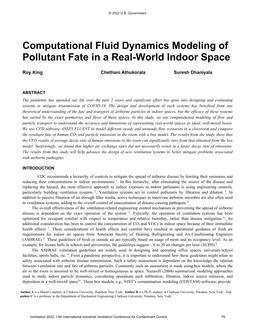Click here to purchase
The pandemic has upended our life over the past 2 years and significant effort has gone into designing and evaluating systems to mitigate transmission of COVID-19. The design and development of such systems has benefited from our theoretical understanding of the fate and transport of airborne particles in indoor spaces, but the efficacy of these systems has varied by the exact geometries and flows of these spaces. In this study, we use computational modeling of flow and particle transport to understand the accuracy and limitations of representing real-world spaces as ideal, well-mixed boxes. We use CFD software ANSYS FLUENT to model different steady and unsteady flow scenarios in a classroom and compare the resultant fate of human CO2 and particle emissions in the room with a box model. The results from the study show that the CFD results of average decay rate of human emissions in the room can significantly vary from that obtained from the box model. Surprisingly, we found that higher air exchange rates did not necessarily result in a faster decay rate of emissions. The results from this study will help advance the design of new ventilation systems to better mitigate problems associated with airborne pathogens.
Product Details
- Published:
- 2022
- Number of Pages:
- 9
- Units of Measure:
- Dual
- File Size:
- 1 file , 1.3 MB
- Product Code(s):
- D-IIVC2022-C011
- Note:
- This product is unavailable in Russia, Belarus
